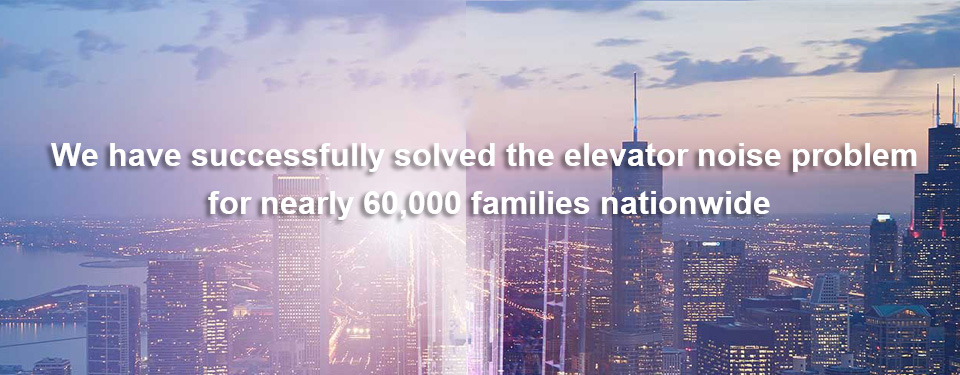With the increasing complaints and lawsuits of elevator guide rail noise, we can see that many elevator manufacturers, some professional environmental protection companies of noise control in China, real estate developers, architectural design units, etc. have strengthened their attention to the prevention and control of elevator guide rail noise in recent years, and have also conducted some research on the vibration control of elevator guide rail And try to practice, but often because of professional limitations, can't make scientific and correct analysis and judgment on the "noise source" and its "propagation principle" of the guide rail noise, which also leads to the situation that the "elevator noise" is not ideal though it has been "controlled" for many times, which often costs a lot of money, but the effect is very limited! On the premise that there is no very successful case and technology promotion in China, the noise prevention and control of elevator guide rail is often just a kind of technical publicity that developers spend money on without knowing, for example, it has no practical significance and utility (for example, the elevator shaft noise reduction system publicized by a real estate company in Shanghai and Hangzhou when selling is actually to do some simple sound absorption and sound insulation for the shaft wall It can not solve the vibration problem of guide rail. According to our research and contact cases on "elevator noise" over the years, there are several major technical errors in the prevention and control of elevator guide rail noise in China as follows:
1. It is a wrong technical judgment to simply understand the sound transmission of guide rail as the air pressure piston effect of elevator high-speed shaft!
According to many practical cases we have contacted, the cases of elevator guide rail noise are generally high-speed elevators, while high-speed elevators have a high taxiing speed, so when people stand in the elevator car or listen in the shaft, it is easy to feel the false sense (because there is a large air pressure and pulling effect in the shaft when the elevator is running at high speed, it is serious to There is a certain sound of wind pressure in the gap of elevator landing door. In this case, it is especially obvious when there is no vent in the machine room or the vent is not set properly). The wrong understanding and judgment of the indoor elevator guide rail noise is mainly caused by the shaft wind speed and pressure, which also leads to the later elevator noise control measures and methods around how to reduce the shaft air pressure piston effect surface (for example, increase the shaft air pressure piston effect surface Tuyere, or conduct environmental protection measures for sound absorption and diffusion in the shaft, so as to reduce the inlet wind speed, etc.). From the situation we have been in contact with for many years, most of our domestic noise control and treatment environmental protection companies or developers often simply understand the elevator noise as the shaft air pressure piston effect, and the elevator noise reduction measures only stay in the improvement of the elevator shaft ventilation and the air inlet and outlet of the machine room, so the treatment effect is not obvious! But in contrast to these practice cases, the so-called noise reduction measures (improvement of shaft air outlet, sound absorption and diffusion of shaft, etc.) only reduce the wind speed effect of shaft to a certain extent, which will have a certain effect on improving the sense of comfort of passengers in the car and the noise decibel in the car; because the vibration noise of the electric ladder guide rail will still be transmitted from the guide rail bracket to the similar owner's room through the wall, because There was no significant reduction in the vibration and noise of the house. It is confirmed from the cases collected in China that the noise in the field test room will be reduced by 2-3 decibels after the above measures are taken, but it is only caused by the impact of the measures on the indoor sound field, and there is no obvious change in the indoor vibration of households and the perception of people on the elevator noise. However, the noise reduction effect can only reduce the indoor noise by 2-3 decibels, and there is no obvious improvement in people's perception. It can be seen that it is a wrong technical judgment to simply understand the sound transmission of guide rail as the air pressure piston effect of elevator shaft at high speed.
2. It is another common mistake to simply understand the structure vibration of elevator guide rail and the sound insulation of shaft wall!
In the elevator noise control technology, we have always stressed that we must master the principle and application of three different noise control measures: sound absorption, sound insulation and vibration reduction, and make a scientific analysis of the noise transmission source, so as to solve the problem. However, due to the late development of architectural acoustics in our country, most of the time, due to the limitation of the acoustic level, the engineers of our domestic developers often simply understand all the noise reduction problems as sound insulation problems (that is, the subjective thought is to isolate the shaft sound through some measures, that is, there is no sound in the owner's home), and seek medical treatment in disorder in the case of urgent need to solve the problems, carry out external bidding, etc; And many of our acoustic companies or environmental protection companies are often limited by objective conditions and non specialty (elevators are special equipment related to personal safety, many companies do not know elevator design, stress structure, elevator installation standards, etc.), and cannot conduct in-depth research, but driven by the company's business sales interests, default and advocate this so-called elevator shaft separation Sound system (it is advocated that the impact sound of the wall can be effectively reduced by 10-20 decibels, but in fact, it is not the same as the horse mouth, and the wrong vibration isolation of the elevator guide rail is treated as the poor sound insulation of the shaft wall). In fact, the wall structure of common hoistway in China is generally 200-240 thick concrete arrow wall. From the analysis of elevator operation noise, as long as the elevator noise is the vibration of high-speed taxiing machinery, the air noise must be below 50 dB. Based on the above situation and the building acoustic data, the analysis is carried out: "general 200-240 thick concrete arrow force

















